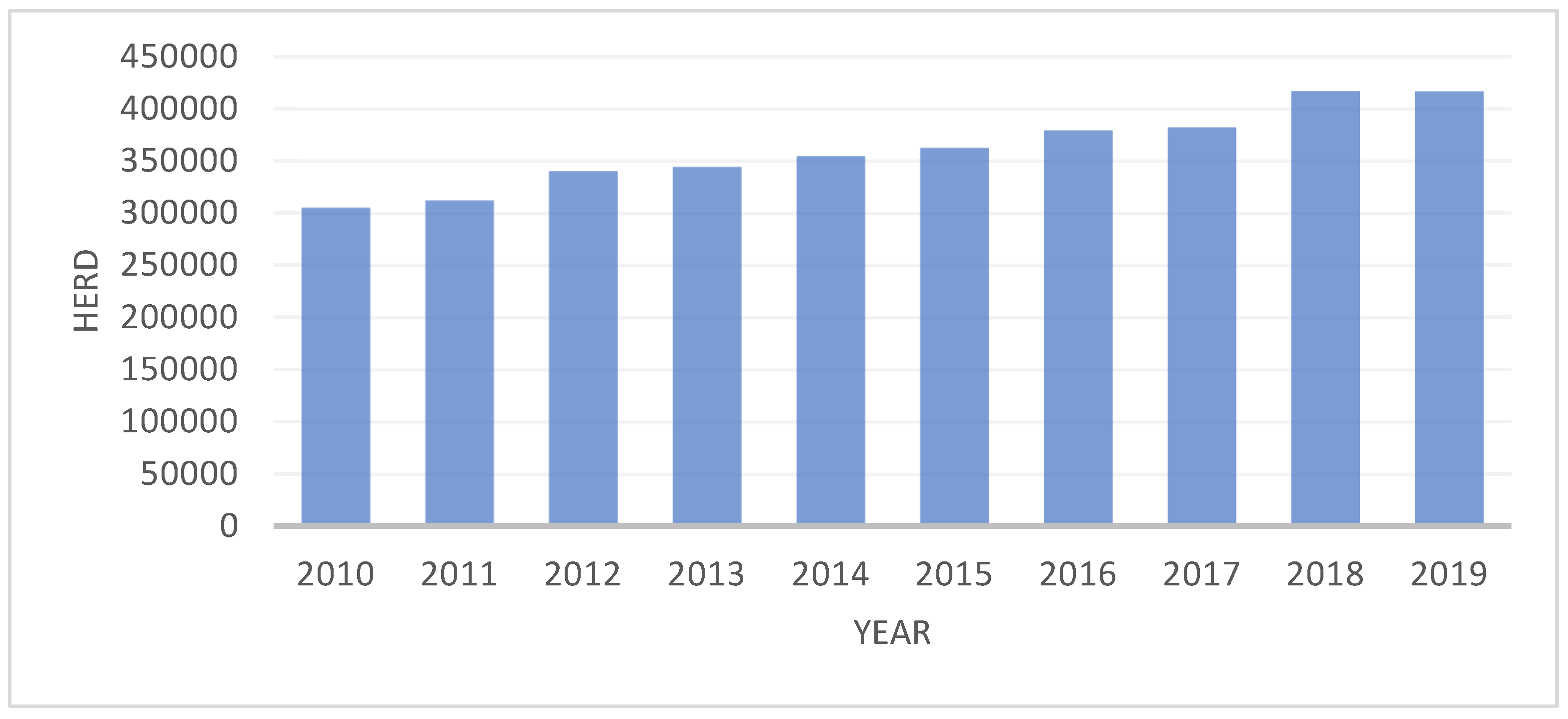1. Introduction
Algeria is the largest African country, with an area of 2,381,741 km
2. It has great diversity in its pedoclimatic conditions and plant and animal genetic resources. Algeria is home to a diverse range of domestically produced animals, including chickens, camels, goats, cattle and sheep [
1].
Arid and desert steppe ecosystems are marked by great landscape diversity in relation to significant variability in ecological factors. Regions with a pastoral tradition are populated with people who are pastoralist–breeders; most of them are former nomads, with a strong tendency for sedentarization today. The dromedary is a multifunctional animal with an excellent capacity to adapt to the conditions of life in arid and semi-arid environments. It can remain alive for a long period without drinking. It is also able to convert meager forage resources, usually untapped by other domestic animals, into energy [
2]. Despite its economic, social and cultural importance, the Algerian camel has been neglected in development programs, and few studies are available on camel husbandry systems in the country.
This study aims to present the most up-to-date situation on camels in Algeria, based on official reports and scientific publications.
2. Current Situation of Camel Breeding in Algeria
The camel population in Algeria was estimated to be about 416,500 in 2019. As shown in
Figure 1, the camel herd has experienced an average annual increase of about 4%. This number places Algeria in 14th place among countries breeding camels. In 1890, the number of camels in Algeria was estimated at 260,000. They decreased to 194,000 in 1910 and to 141,000 in 1986 [
3]. The dromedary is present in 17 Wilayates (8 Saharan and 9 Steppic). There are three main distribution areas. With 56% of the national livestock, the central Sahara is the major distribution area of the dromedary in Algeria. The two other areas are the Northern Sahara (37%) and the steppe (7%). The main camel breeds in Algeria are the Chaambi, Ouled Sidi Cheikh, Ait Khebbach, Chameau de la steppe, Saharaoui, Targui, Ajjer, Reguibi and Ftouh [
3].
3. Dromedary Breeding Systems in Algeria
Traditionally, in camel farming, spatial mobility of the herds is the first strategy recommended for the search of sufficient feed and water for herds. The exploitation of pastures constitutes the basis of dromedary feeding. The feeding behavior of the dromedary contributes to a rational use of natural resources with greater variability in the consumed plants. The dromedary contributes significantly towards the fight against desertification, consuming a wide variety of forage species, both botanically and chemically, some of which are rejected by other domestic ruminants. The dromedaries are raised in Algeria following three systems of breeding: sedentary, nomadic and transhumant. However, due to the alarming change in the security situation in recent years, dromedary farms are mainly of a “sedentary” type with a strong exploitation of the pastures around the farms.
4. Use of Dromedary in Algeria
In general, breeders rely on four main qualities: (i) species diversity, (ii) adaptation to the environment, (iii) hardiness and (iv) versatility to constitute their herd. As in other countries, the use of dromedary in Algeria is very numerous. Milk is often consumed fresh and/or fermented by breeders. Some breeders mix the milk from their camels with that of goat milk to produce butter and fresh cheese, for example, Oudi ouanamellen, tikamarine (cheese) and Oudi ouanamellen (butter) among the Tuareg. These products are intended for self-consumption. Camel meat represents 3% of Algerian red meat production. The camel represents one-third of the slaughtered animals in the southern wilayas. The meat is often consumed boiled. Nomads are very fond of the hump fat. The oubar is a raw material that is required for manufacturing a whole range of products necessary to the nomadic life (bags, blankets, shackles). The dromedary hair has a very good market value. In Algeria, the burnous in oubar is very appreciated and expensive, especially when it is made with the hairs of young dromedary. The skin is usually thrown away. However, some Tuareg craftsmen take advantage of this opportunity to transform it into “iretmen”, and good-quality soles are offered for sale in the city market at good prices. Other camel breeders, especially those of the Hoggar, continue to exploit it to obtain a whole range of products necessary for their daily life: “ahloum”, ropes used to draw water, “ikchir”, a kind of bag to keep certain supplies, as well as carpets. The dromedary is also used in Algeria for work, including plowing, transporting goods and people and drawing water from deep wells.
5. Conclusions
Camel breeding in Algeria can be improved through efforts at three levels: technical, commercial and institutional. At the technical level, improvements in farm productivity imply interventions in various fields, such as animal health, livestock feeding or even the technical management of herds. At the commercial level, it is essential to enhance the commercial value by improving the conditions required for better access to the markets. At the institutional level, an articulation of the interventions of the institutional actors involved in the field of camel breeding in Algeria must be improved to find sustainable solutions to the problems of the breeders.






